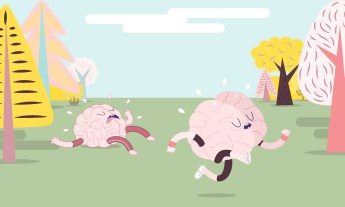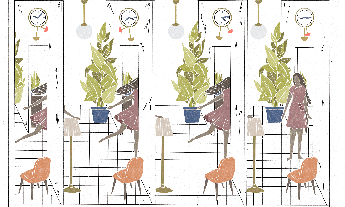
Feeling like you’ve got all the time in the world is a wonderful sensation; too bad it occurs so rarely. But by developing the skill of savoring, you can maximize your moments — and your experience of time, according to author Laura Vanderkam.
People who feel like time is abundant approach the present in two ways. There’s the practical: they learn to be where they’re supposed to be in enough time that they can relax. Then, the more daring psychological feat: they find ways to savor the space of time where they currently are.
Actively savoring the present stretches your experience of time. To savor is to feel pleasure, and also to appreciate that you are feeling pleasure. It takes normal gratification and adds a second layer to it: acknowledgment. That this appreciation expands time can be understood by thinking of the opposite. When you want time to pass quickly, you might wish yourself elsewhere. When you want to prolong something, you hold yourself right where you are.
The richest experiences of savoring involve an awareness of the past and the future, as well as the present.
The concept of savoring turns out to be a critical component in the field of positive psychology. Intriguingly, the richest experiences of savoring involve an awareness of the past and the future, as well as the present. In their book Savoring: A New Model of Positive Experience, researchers Fred B. Bryant and the late Joseph Veroff share Bryant’s account of summiting the 14,000-plus-foot Snowmass Mountain in Colorado.
He was in awe of the physical grandeur, of course. But he also knew he’d likely never be there again, so he did more than enjoy the view. He embraced his friends and told them how happy he was to share this moment with them. He looked back into the past, recalling a back injury that had almost ended his climbing career. He let his mind go to a time when he thought he would never experience this moment. “The realization that it is here now intensifies my joy,” he thought.
Bryant projected himself forward into the future and thought about how he might look back on this memory. He thanked God for enabling him to be there, and for creating mountains to climb. Then with “a strong sense of the fleetingness of the moment” and a desire “to remember this moment” for the rest of his life, he made special efforts to capture the scene. He turned in a deliberate circle and recorded small details: a forest of aspen and spruce, a river below. He noticed how his lungs felt, what he was smelling. He felt the cold. He selected a stone from the summit as a souvenir. He thought of sharing the memory of the mountain with his loved ones and thought of his late grandfather, who also loved outdoor adventures.
Bryant and his companions weren’t on the summit long. But all this savoring made the experience seem more vast than the ten minutes he told me it encompassed. Down off the mountain, he worked with Veroff to learn more about how people savor happy moments.
Scanning the past and imagining the future were intimately part of the experience. “A conceptual model of savoring must consider not only reminiscence, but also anticipatory processes,” they wrote. They produced the “Ways of Savoring Checklist,” which they used to evaluate how different people hold on to experiences. For a research document in an academic book, it’s a surprisingly practical tool kit of dozens of strategies.
“There are so many ways to use the mind as a time machine,” says researcher Fred B. Bryant. “Mental time travel is so beautiful and rich.”
For instance:
● You can think about sharing the memory later with other people, or consciously taking in every scent during the event.
● You might remind yourself how long you had waited for this event to happen, or think back to a time when the event hadn’t happened and you really wanted it to.
● You might try to become more alert, take deep breaths, or slow down.
● You might tell anyone else there how much you value the moment and how happy you are that the other people are there with you.
● You could remind yourself that nothing lasts forever. And so, you must enjoy this moment now.
Any good event can be deepened in these doable ways. Bryant, who calls savoring “an acquired skill,” has his own tactics to cultivate savoring. He teaches psychology classes at Loyola University Chicago. In my experience, professors sometimes grumble about teaching undergraduates. Bryant, on the other hand, envisions himself at a nursing home in the future. His health is failing. He can no longer get around on his own. He pictures himself looking back on his life and wishing he could be in front of a classroom again, feeling healthy and mentally alert. Oh, what he would give for just one more day. Then he opens his eyes and realizes, “That’s today!” He doesn’t have to give up anything to get this privilege. This contrast — akin to George Bailey getting his second chance in It’s a Wonderful Life — awakens him to the joys of normalcy. “There are so many ways to use the mind as a time machine,” says Bryant. “Mental time travel is so beautiful and rich.”
By clearing the calendar of what you don’t want to do, you can linger when you’re doing the things you do want to do.
You can also engineer lingering moments. By clearing the calendar of what you don’t want to do, you can linger when you’re doing the things you do want to do. An after-work happy hour can turn into dinner. A planned ten-mile bike ride on an out-and-back trail can become sixteen miles if the weather is nice. I love to create completely open days when all I do is write. I’m off the clock and savoring a project I’m really getting into.
If setting aside a whole day is not possible, try what Bryant and Veroff called the “Daily Vacation Exercise.” This is a compact way to allow you to practice lingering in pleasurable experiences. Each day for one week, plan to do something enjoyable for ten to twenty minutes. Some recent vacations for Bryant have included playing the guitar, composing music, walking his dog and calling an old friend.
Here are a few possibilities for your daily vacation:
● watching the sunset
● sitting outside at a café with a good cup of coffee
● visiting a bookstore on your lunch break
● going for a walk in a nearby park
Choose a time when you can minimize distractions, so put your phone away or in airplane mode. During your daily vacation, per Bryant and Veroff, “try to notice and explicitly acknowledge to yourself each stimulus or sensation that you find pleasurable. Identify your positive feelings, and explicitly label them in your mind. Actively build a memory of the feeling and the stimuli associated with it, close your eyes, swish the feeling around in your mind, and outwardly express the positive feeling in some way.” At the end of the week, recall all seven vacations.
The truth is, we take 10-minute breaks in normal life anyway. We fill this time by deleting emails, we scroll through social media or we putter around our houses, so this doesn’t register as leisure time. Consciously lingering in pleasurable downtime reminds us we have downtime. And that can make us feel like we have more time than when it slips through our hands.
If rushing makes people feel like they lack time for things they want to do, then conscious deliberation can feel like a treat.
Another way to practice savoring: if you don’t have to move fast, try moving slow. If rushing makes people feel like they lack time for things they want to do, then conscious deliberation can feel like a treat. Bryant reports that in the lab, when subjects are given a chocolate-chip cookie and told to max out on their enjoyment of it, they almost universally slow down. They try to notice each bite fully. He says, “Slowing down makes it last longer. The enjoyment itself is sustained.”
Moving slowly also allows you to pay attention to more things. “Slowing down is a conscious effort, so you’re controlling the experience, and you’re becoming more aware of what’s going on,” says Bryant. This slowness can be as delicious as a savored cookie. I might read a book more slowly if I am enjoying it. While there is pleasure in figuring out how something ends, there is also pleasure in rereading a few sentences of choice prose.
But I wish to stress that not all parts of life lend themselves to slowing down. Sometimes slowness is lingering, and sometimes it’s dilly-dallying. Furthermore, not all situations deserve lingering. Frequent flyers learn to arrive at the gate just in time to board. In addition, small children and their short attention spans naturally reduce the time spent on many activities. By myself I might spend hours in a museum; taking a kid, I aim for an hour and feel lucky if we make that. As the mother of three small children, I know that many ideas for living the good life are harder to implement when you have toddlers. Even if you’re sitting in front of a delightful fire, it is hard to linger in the moment when you’re trying to keep a child from leaping into the fireplace.
Lingering is about enjoying the enjoyable. It’s about understanding you have the power to stretch time when you are in it and when you wish to stretch it. All time passes, and you cannot linger in anything forever. Hedonic adaptation — which is the human tendency to become accustomed to anything — means even a view from the mountaintop becomes the scene out the kitchen window after a while. But for a few minutes, with the right mind-set, it can be more.
Excerpted from the new book Off the Clock: Feel Less Busy While Getting More Done by Laura Vanderkam. Published by Portfolio/Penguin, an imprint of Penguin Random House LLC, New York. Copyright © 2018 by Laura Vanderkam.












